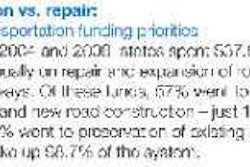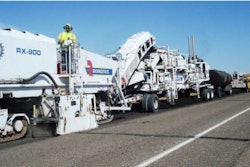
(when they’re not very good)
How some city road managers cope with diminishing budgets
By Kirk Landers
With Stimulus money slowing to a trickle and local tax revenues still sagging, Better Roads interviewed a cross-section of city road managers to find out what they are doing with the funds they have available.
With the federal transportation program foundering, and state and local tax revenues locked in the throes of the Great Recession, road managers all over the country are struggling to maintain the integrity of pavements and bridges. While major interstates and high-volume freeways get funding priority in times like these, thousands of lane-miles of surface streets in metropolitan areas carry high volumes of traffic and are an essential part of area commerce and lifestyle. And beyond those high-volume roads are residential streets that, though low on the triage scale, have safety, environmental and political implications.
Given the sobering reality in rural communities where some paved roads are being returned to gravel due to inadequate funds (See “Weighing the Options,” Better Roads, April 2011), we wondered how their counterparts in urban/suburban America were being managed. To gather some idea of today’s urban road realities, we engaged a random assortment of city road managers in a series of informal conversations.
Our informal, unscientific conversational poll turned up both good news and bad news.
The bad news is what we expected: funds for roads are becoming desperately inadequate in many places, and there is an air of uncertainty almost everywhere due to the absence of a long-term federal program and chronic weakness in tax revenues at all levels of government.
The good news is that it’s not all bad news. Some city governments are finding reason — and resources — to pursue aggressive road programs. And even in cities where road funds have atrophied badly, road managers are employing new strategies and tactics to protect the public’s investment in road infrastructure until the Great Recession gives way to the Great Recovery.
Bridge Watch
Bridge repair and replacement can overwhelm any municipal road budget, even in the best of times, and in times like these, managers are scrambling to prevent the need for expensive interventions.

Rock Miller, a principal of Stantec, one of North America’s major highway and bridge consulting engineering firms, notes that bridge replacement has become an especially dicey proposition. “We are in an era of dwindling resources,” he observes. “We have to do more with less, but in many areas, the available funds aren’t even enough to cover maintenance expenses because funding has declined and maintenance costs have gone up.
“There have been a lot of innovations in pavement and bridge technology, but we don’t have the ability to fund them,” he notes.
Of course, when bridges become dangerously near the end of their service lives, communities often have to do something. That something, says Miller, may be tolling. He cites as an example a floating bridge in Seattle, which will sink in a few years. “The price tag for replacing that bridge is the entire budget capability of the region,” says Miller. “The best option they have is to rebuild it as a toll bridge, and we may see a lot of that sort of thing as time goes on.”
Miller notes that tolling projects are bondable. “That may be the only way to raise $300 million for a bridge for some agencies,” he says.
Miller adds that Illinois and Indiana are two states that have gotten money from the bond market with toll roads and bridges, while states like Texas and Florida are considering such projects and California leaders are discussing tolls for solo drivers in carpool lanes as a way of raising funds for roads and bridges.
Best Outcome Solutions
Every manager we interview emphasizes longer-lasting solutions as part of their agency’s urban road strategy today, though the tactics employed by each agency varied according to local needs and priorities.
For Ron Ditmars in Overland Park, Kan., the single most cost-effective pavement intervention is crack sealing. Ditmars is supervisor of public works maintenance for the city, which is part of the greater Kansas City metropolitan area and has a population of about 173,000.
“With revenue trends like they are, we’re focusing on maintenance technologies that cost the least and give the most return,” says Ditmars. The city’s maintenance priorities, he says, are crack sealing, milling and paving patches, and repairing base failures. In-house crews tend to the crack sealing and patching, and some of the base failures, while larger base repairs and milling and paving work are contracted out.

Overland Park classifies its roads in three categories: residential, collectors and thoroughfares. The thoroughfares, says Ditmars, get milling and overlay interventions on a shorter cycle – 10 years or more – with microsurfacing treatments following five or six years later. Chip seals are not used on thoroughfares.
The city has been experimenting with several surface treatment options. A rejuvenating oil to treat aging surface asphalt has gotten negative public reception due to material being tracked into homes. The city is using different stone and oil combinations for its microsurfacing mixes, and officials there are looking at options like crumb rubber, river rock and hadite to either lower costs or extend service, or both.
Ditmars says the city also gives high priority to drainage for its streets, because water in the pavement can create expensive damage and safety problems. “One of our most important missions is to keep the underdrains open on some of our thoroughfares so the medians can drain properly,” says Ditmars. Similarly, when city crews repair failed bases, water is often the source of the problem, so they install underdrains as part of the repair.
Ground Failure Before Pavement Failure
For Mike Coffey, Alaska DOT maintenance and operations engineer, and his Fairbanks counterpart, Steve Potter, their state presents a set of road management problems that range from the unique to the nearly bizarre, but they have one thing in common with road managers everywhere: “We face higher expectations from the public every year,” says Coffey.
“The public wants a higher level of service and we try to provide that from a budget that generally doesn’t grow as fast as expectations.”
Because Alaska is a massive state with a small population, its transportation structure is different than other states. It derives a higher percentage of its road budget from federal funds, and the state DOT works more directly with city and local roads than in other states.
“We’re doing more with less, like everyone else,” says Coffey, of Alaska DOT. “In the old days we might have had three trucks and a grader on a job, now it’s one truck and a grader. All the trucks have attachments like front plows, belly blades, and sanders so they can do multiple tasks.”
Coffey says the agency has reduced its inventory of specialized equipment, in some cases by renting, and in other by replacing specialized machines with multi-use units.
As in other places, safety problems trump all other priorities, even in this tight budget era. In the Fairbanks area, the state has recently invested in a salt-brining system to deal with a changing climate that makes the fall to winter transition longer, with more freeze-thaw cycles. Coffey says the transition begins in October and often includes heavy and freezing rains, in addition to traditional winter weather.
“We were exhausting our supply of brine that was based on a more traditional, shorter transition to winter,” says Coffey, “and that is dangerous.” The new system has five stations that produce an enhanced brine that includes sodium chloride and an organic ingredient.
In trying to stretch pavement life, Alaska’s road professionals face some unique problems. In the southeastern part of the state, cities like Anchorage and Juneau face the twin curse of soft local aggregate and a long season of studded tires that includes periods of clear streets. The result is premature rutting. To achieve a longer-lasting, more cost-effective solution, the DOT is importing harder aggregate from British Columbia for its surface asphalt mixes.
In Fairbanks and the northern part of the state, the most severe and unique road problems stem from the fact that roads are built on permafrost, which becomes a weak, unstable base when it thaws in the spring. “We can build a 20- to 25-year pavement,” says Coffey, “but the ground fails before the pavement does.”
Northern Alaska’s extreme weather and soil combination can produce awe-inspiring effects in the spring, including roller-coaster-like undulations and long horizontal cracks in the pavement. “The horizontal cracks stem from the fact that the roadway fill is thicker at the centerline and gets thinner as you move out,” explains Coffey. “If the road has a 2:1 slope, there may be 6 feet of fill under the center line tapering to 4 feet of fill just beyond the edge of the pavement. This means the center is more insulated than the shoulders from the cold and heat, and that causes the differential warming of the permafrost under the road and the damage that follows.”
As a result, Alaska reclaims a lot of surface pavement each summer in the north and invests less in traditional pavement maintenance interventions used in the lower 48 states.
The DOT has also worked to reduce the destructive effects of the pavement/permafrost temperature differentiation by developing its own snow plowing tactics. “We’re in the refrigeration business,” laughs Coffey. “To reduce the effects of differential heating, we’ve been experimenting with plowing the road shoulders when we clear the streets. If the snow is piled on the shoulder, it insulates that ground and increases the temperature differential between the pavement and the ground next to it, which causes cracking.” The shoulder-plowing technique has been an effective tactic in reducing that problem.
For Fairbanks’ maintenance supervisor Potter, the plowing solution is an important one. “We can’t use chemicals in much of the winter because our temperatures are too low,” he says. And winters are much longer in Fairbanks than elsewhere in the U.S. — “our temperatures go below zero F by the end of October and ground temperatures remain below zero F well into April.”
Potter’s road management interventions include prolific use of foamed asphalt and cold recycling, as well as warm-mix asphalt and some testing of open-graded asphalt.
Cities Taking Action
Paul Klope and the city of Eugene, Ore., serve to remind us that local governments find the means to do what must be done. Eugene, a city of 138,000 in west-central Oregon, passed a five-year, $36-million bond measure in 2008 to repair the city’s long-neglected roads. This, combined with a city gas tax, federal STP-U (Surface Transportation Program–Urban) funds, some recent state and county funding and a chunk of Stimulus money ramped up the funds to provide what Klope calls “an amazingly robust” pavement program. These funding levels will continue for at least another couple of years.
“The investment was long overdue and the timing was a blessing for everyone,” says Klope. “We’re getting great bid prices because of the competition for work, but it’s good for the contractors, too, because we’re able to pave even more streets.”
The size of the city’s program has given Eugene’s pavement managers an opportunity to invest in several pavement technologies that are projected to yield higher cost-benefit performance than the pavements they replace.
One area of special emphasis is employing recycled asphalt shingles (RAS) as part of the city’s asphalt mixes. “The Oregon spec allows us to use 30-percent reclaimed asphalt pavement (RAP), or 20-percent RAP and 5-percent RAS,” says Klope.
“We won’t know if there’s any financial savings until we’ve done it, but using RAS helps us achieve city council goals for environmental stewardship,” says Klope. “The process is new to local contractors, so we’ll see what happens when we build more projects where RAS is allowed.”
Eugene changed its design policies in 2008, shifting from thin pavements over thick rock bases to full-depth asphalt to reduce the long-term costs of its road program. Research shows that the city’s 30- and 40-year-old full-depth pavements are in much better structural condition than traditional thin asphalt streets and much less expensive to rehabilitate.
The city began using full-depth reclamation (FDR) in the reconstruction of selected streets in 2009. “We have poor soils here, so we use FDR with a portland cement additive to create a strong platform,” explains Klope. “We started with three local streets and it went so well that we added more local streets and an arterial last year. Because of local soil conditions, Klope says the city’s FDR process digs deeper into the soil than typical reclamation practices and can use a much higher mix of portland cement — up to 8 percent.
Eugene is also testing whitetopping as a solution for an intersection that has a high volume of heavy trucks. The city milled 6 inches of the old asphalt pavement and placed 6 inches of concrete on top of it. It is the city’s first use of whitetopping on a street, though the technology has commonly been used for bike paths in Eugene.
Eugene is also making a major commitment to warm-mix asphalt, using it for almost all of its paving projects since 2009 – a total of more than 120,000 tons so far. The city adopted warm mix for environmental reasons and in hopes of some slight gain in lifecycle cost efficiency. “We like the higher-effect asphalt content,” says Klope, “and we hope that translates into longer life. Meanwhile, it meets our community’s environmental goals and it’s good for workers.”
Klope says Eugene contractors have found warm mix a little easier and faster to compact than hot mix, but they don’t like raking it; therefore, small, irregular areas are often done with hot mix.
Life Goes On
While the specter of inadequate budgets hangs over many state and local road agencies today, most road agencies are trying to maintain current levels of pavement and bridge condition until the economy recovers and budgets return to normal levels.
“Metro government has put a lot of its efforts into maintenance activities, with potholing, overlays and crack sealing to extend our pavement life with more cost-effective measures,” says Jeremy Raney, executive administrator in the Louisville, Ky., Department of Public Works and Assets. “Most of our efforts are currently focused on maintenance of existing structures and replacing those that have more severe deterioration.”
Like many other road departments, Louisville was able to use Stimulus funds for critical upgrades, but now faces a much tighter budget and more limited capabilities.
Still, says Raney, Louisville is using its asset management system to establish priorities for bridge and pavement rehabilitation, and the city’s maintenance department is focused on critical preservation activities, including replacement of deteriorated cross drains and shoulder repairs.
Ironically, our conversation with Raney was delayed and truncated by severe weather and flooding in the Louisville area last spring, a reminder to us all in this period of taut budgets and growing needs that all strategies and tactics are subject to the whims of natural events.
Working a Watershed in Winter
Recession or not, the environment needs help
Even in the dark shadows of the Great Recession, the need to develop road designs with sounder environmental attributes is a driving force in many areas.
In the Twin Cities suburb of Robbinsdale, a partnership of road and watershed management agencies is working with the Minnesota Asphalt Pavement Association and the consulting firm of Wenck Associates on a three-year study to see if the use of porous asphalt can reduce the need for road salt in an environmentally sensitive watershed area.
The Shingle Creek Paired Intersection Project was launched in 2009 with a $282,000 research grant and the construction of 150-foot test sections of porous asphalt and conventional asphalt on a Robbinsdale residential street with a sandy subgrade. A second test site was built in 2010 on a clay/loam subgrade.
“We will monitor these sections for three years,” says Ed Matthiesen, a consultant with Wenck Associates. “We want to estimate the effectiveness of porous asphalt in reducing the need for salt as a de-icer and determine whether porous asphalt can stand up to the rigors of residential street use.” In addition, the study will determine short-term maintenance requirements and project long-term requirements, and the team will measure the water quality and quantity performance of porous asphalt.
Though the study won’t be completed until 2013, the intermediate results have been promising. “The control sections with salt tend to melt faster than the unsalted porous asphalt sections, but there is less refreezing of melted snow and ice on the porous pavement,” says Matthiesen. “And it appears to work just as well as salted pavement at clearing ice buildup.”
After two winters for one section, and one winter for the other, Matthiesen says the porous pavements are holding up well with no visible signs of distress from traffic, plows or weather.
The porous test sections include 1.5 to 2.5 inches of asphalt with 40-percent void, a choker layer of 0.5 to 1.0 inches, and a 0.25- to 0.75-inch layer of porous aggregate. Cellulose fiber and mineral filler were added to the binder to achieve a draindown of less than 0.3 percent.
Temperature sensors have shown the porous asphalt has insulating properties; the test sections are warmer than the control sections an inch below the surface. In addition, the porous sections have been more responsive to solar radiation, producing a faster melt and more bare pavement on sunny days compared to the control sections.












